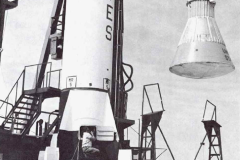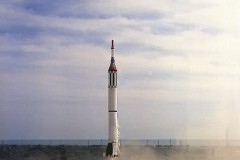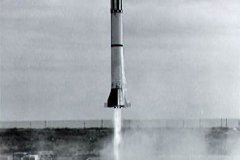Mercury-Redstone Booster Development (MR-BD) was the final unmanned mission to test the Redstone rocket for manned flights as part of the American Mercury program. A dummy capsule (Mercury boilerplate) with a dummy rescue rocket was used.
After the flight of MR-2 with the chimpanzee Ham, it was clear that the problems that had arisen with the Redstone rocket had to be solved before a manned launch
The reason for the excessive acceleration on the previous flight was a faulty valve that controlled the flow of hydrogen peroxide to the steam generator, causing the fuel pumps to run too fast. Therefore, on this and subsequent Mercury-Redstone missions, the rocket was modified to correct this problem. In addition, the rocket was made less sensitive to vibrations through four reinforcements.
The launch took place on March 24, 1961 from Launch Complex 5 (LC-5) at Cape Canaveral. The MR-BD mission lasted eight minutes and 23 seconds. As intended, the capsule was not separated from the rocket. The team reached a summit height of approx. 182 km and covered a distance of 494 km and then sank into the Atlantic.
MR-BD was extremely successful and paved the way for Alan Shepard’s flight aboard MR-3.
Mission data |
|
|---|---|
Mission |
Mercury-Redstone BD (MR-BD) |
Rocket |
Redstone MRLV, MR-5 |
Spacecraft |
Mercury Boilerplate |
Launch date |
March 24, 1961 |
Launch site |
Launch Complex 5 (LC-5), Cape Canaveral, Florida |
Mission duration |
8 min 23 sec |
Altitude |
182 km |
Distance |
494 km |
Velocity |
8,245 km/h |
Max G |
11 g |



